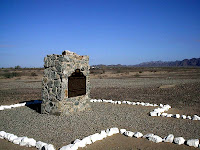From the Plank Road we head east on I-8 to Felicity and Camp Pilot Knob and get an extra roadside attraction thrown in. Felicity is named after Jacques-Andre Istel’s wife Felicia, and Jacques-Andre somehow got Imperial County France US
The nature of the stop however is Camp Pilot Knob and it’s just east of the center of the world and one of seven of the ‘985’s’……the series of Desert Training Centers of World War II. And training was tough. One exercise was a mile run in the midday heat with full gear and rifle and it had to be done in under 10 minutes.
August 17, 1944
Anne Darling, What a week this has been so far. I have so much to tell you I don't know where to start. Last night we went on a night problem on compass reading. I was picked as patrol leader of patrol #11. There were six patrols of 10 men each in our platoon. I was responsible for these men and getting back in time. After the long hike on Tuesday night we were in no mood for another last night but we all did it. - Your ever loving husband, Joe
Plaque Inscription: State Historical Landmark No. 985
Location: Sidewinder Rd, 200 yds North of I-8, town of Felicity (.25 mi. East of the 'Center Of The World' attraction).
Google maps: 32.748986,-114.754686
Camp Pilot Knob is 11.5 miles from Plank Road
This is virtually the same song as ‘Training Center Boogie’ and can be viewed here:
PILOT KNOB BOOGIE
Well the sun's gone down I got a minute to write
A letter to you mama here by candlelight
No sheets on my cot in this tent we're in
Somebody said today it was 110
No refrigerator no electricity
At Camp Pilot Knob that's the way it has to be
You know I joined this army to get into the war
And I'm training the desert, June of 1944
Dancin' with the cactus do the shuffle with the sand
Do the swing with the buzzards jitterbug when we can
But there's a special one we do and it's a goodie
A little jive dance they call the Pilot Knob boogie
Chorus - Pilot Knob boogie's not a dance you see
A mile run in the sun when it's 103
Full pack and a rifle here we go again
Get it out this minute, get it in under ten
We're getting up tomorrow at a quarter to four
Marching to the border on the desert floor
Then it's rations with a passion in the noonday sun
Can't wait to get started it really sounds like fun
March back to the camp in the afternoon
Thank you Mr. Sergeant for this lovely day in June
Waitin' for the minute when the order comes around
We're going of to Europe , put old Hitler down
This 85th division of the infantry
Gonna dance on Hitler's grave for everyone to see
Cause there's a special one we do and it's a goodie
A little jive dance we call the Pilot Knob boogie














































